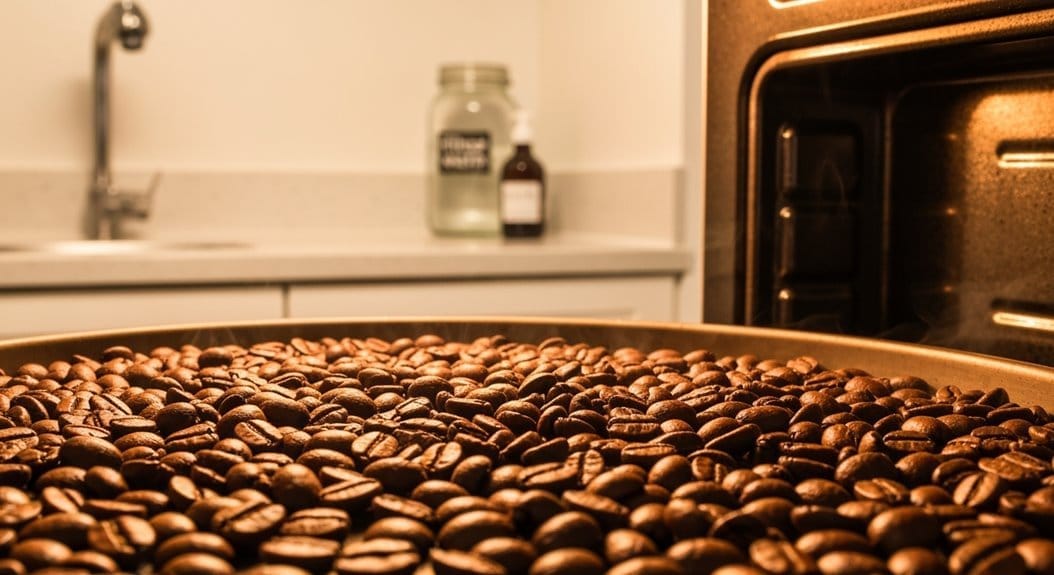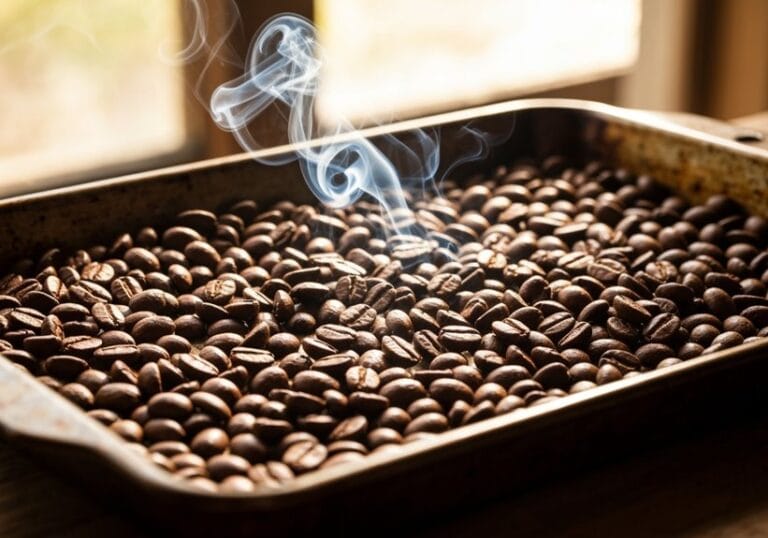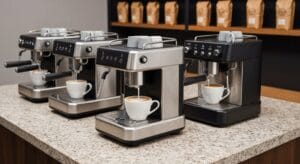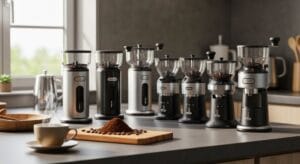Roasting coffee beans in the oven is like juggling chainsaws—sure, it sounds exciting, but one slip can turn your beans into burnt offerings! Aim for temperatures between 180°C and 250°C, and keep an eye on that initial crack like a hawk (or your mom on your TikTok). Ovens can cause uneven roasting, risking a smoky disaster, so don’t wander off! Use good ventilation and heat-resistant gloves—trust me, you’ll thank yourself later! Stick around for tips on perfecting your roast!
Key Takeaways
- Preheat the oven to 180°C to 250°C for optimal roasting temperature, ensuring all beans roast evenly.
- Spread beans in a single layer on a baking sheet to promote uniform heating and prevent burning.
- Monitor the roast closely, especially for the first crack, to achieve the desired flavor profile without over-roasting.
- Maintain good ventilation in the kitchen to avoid smoke buildup and unpleasant odors during the roasting process.
- Use heat-resistant gloves when handling the hot baking sheet to prevent burns and ensure safe roasting.
Understanding Roasting Parameters
When diving into the wild world of roasting coffee beans, you have to get your head around the roasting parameters, which, believe it or not, can turn your at-home brewing experience from “meh” to “oh wow!” faster than you can say “espresso shot!”
Mastering roasting parameters unlocks the secret to elevating your coffee game from bland to bold in no time!
So, to kick things off, let’s talk temperatures—because, let’s face it, if you don’t know when to crank it up and when to take it easy, you might end up with a batch that smells like burnt toast (ugh, right?).
Roasting itself happens between 180°C and 250°C, with those magic moments—first and ensuing cracks—marking key stages. Understanding the importance of temperature and roasting time in this process is crucial for achieving the desired flavor profile.
Pair this with airflow control, because too much or too little can turn your coffee dreams into a roast horror show!
Effects on Flavor and Acidity
Roasting coffee isn’t just about making those beans look nice and brown; it’s a whole science, kind of like alchemy, but with less danger and more caffeine. The full immersion brewing method emphasizes the importance of extracting robust flavors, which you can achieve even during roasting.
In terms of ovens versus commercial roasters, the game changes. Ovens can be tricky, leading to uneven heating which might leave some beans scorched like an overcooked steak! Who wants burnt coffee, right? The control challenges with ovens can mean sacrificing brightness and acidity, resulting in that sad, baked flavor—yuck! Ideally, you’d monitor that sweet spot (hello, initial crack!) to keep those fruity notes alive. Neglect that, and it’s dullsville. Uniform bean size is crucial for even roast development, so consider that while roasting.
The roast level really matters for flavor and acidity, so choose wisely, or risk a coffee catastrophe.
Health Considerations and Contaminant Management

Getting into coffee roasting is like jumping down a rabbit hole of heat, flavor, and surprise, and it comes with its own set of health considerations that can really throw a wrench into the fun!
To begin with, managing ventilation is key—nobody wants their home smelling like a smokehouse, right? Keeping those vents clear means avoiding a smoky workout for your lungs!
And let’s not even start on burn prevention—those ovens can get hotter than a jalapeño in July! Wearing heat-resistant gloves is like having superhero hands, and never, ever leave that roaster unattended—you might come back to a surprise fireball.
Frequently Asked Questions
Can I Roast Coffee Beans Multiple Times in the Oven?
Yes, repeated roasting can be performed in the oven. However, it often alters flavor profiles, leading to muted acidity and potential bitterness, and risks uneven roasting, impacting total coffee quality and complexity.
What Type of Coffee Beans Are Best for Oven Roasting?
For oven roasting, Arabica varieties are generally preferred due to their superior flavor profiles, while Robusta beans can be used for stronger blends. Choosing high-quality, uniform beans improves the general roasting experience and flavor development.
How Do I Store Freshly Roasted Coffee Beans?
Freshly roasted coffee beans should be stored in airtight containers, ideally in a cool, stable environment. This minimizes oxygen exposure and light degradation, ensuring peak freshness and flavor retention for an extended period.
Can I Add Flavors During the Roasting Process?
Yes, adding flavors during roasting uses different flavor infusion techniques. However, one must consider roasting temperature impacts, as these can alter moisture levels, roasting times, and the overall extraction of flavors from added ingredients.
How Long Can I Keep Roasted Coffee Beans Before They Go Stale?
Roasted coffee beans can remain fresh for up to one year when unopened. Freshness factors include storage solutions like airtight containers and cool environments, with peak flavor lasting 7-14 days post-opening before noticeable degradation occurs.
References
- https://www.tandfonline.com/doi/full/10.1080/15428052.2025.2524603?src=
- https://www.nature.com/articles/s41598-024-57256-y
- https://pmc.ncbi.nlm.nih.gov/articles/PMC10138461/
- https://pmc.ncbi.nlm.nih.gov/articles/PMC7684626/
- https://ifst.onlinelibrary.wiley.com/doi/abs/10.1111/jfpp.14874
- https://inthekitch.net/how-to-roast-coffee-beans/





